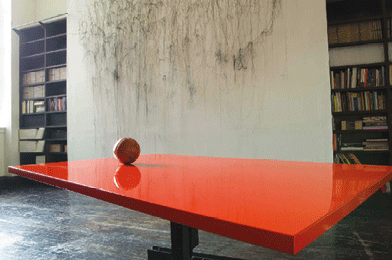Serge Spitzer’s site-specific arrangements
Off the beaten track can be worth the effort. Nyehaus, housed in the National Arts Club Building, brings you to the picturesque neighborhood of Gramercy Park. After making one’s way through the considerable labyrinth of the old world Club filled with pastels and paintings, the elevator leaves visitors at a shockingly white minimal space on the eighth floor.
On a high wall, a continuous piece of thread, “Fold,” (Gramercy) 2005-2006 fills the surface by falling majestically, one line after another, like water. Organized yet loose, its mood is peaceful and organic, the threads’ weight and twisted lines suggest cascading falls in stop action. Adjacent and up high, “Deadload-Deadlock,” 1986 presents a coiled rug, perched on a beam protruding from the wall; a surreal arrangement, provocative and oddly precious. Hovering on the third wall are two brown paper covered canvases held in place along the outside by an asymmetrical arrangement of rubber bumpers. Is this a group show? No, this is an opportunity for American audiences to get acquainted with Serge Spitzer’s elegant, deceptively simple, and confounding work. Spitzer gives new meaning to the notion of site specific.
Born in Romania and based in Germany and New York, his work is well represented in European institutions. Spitzer states, “Unless I feel a complicity with a place, I do not act.”
The exhibition continues two floors below, down an institutional staircase. A second space, old and original with shelves of books provides dramatic contrast with the renovated white space of the eighth floor gallery. Here another surreal spectacle unfolds, “Global Culture”(Red) 2004-2005, in which a large shiny red table top moves erratically, the movement keeping a leather soccer ball from going off the edge. The effect is otherworldly, like a Harry Potter episode. The table is actually a complex robotic mechanism filled with sensors.
Looming high above the table “Upload” (Gramercy), 2005-2006, is another thread drawing, looking like it has experienced electroshock, its tangled and expressive clumps dangling in expressive chaos, charged and powerful.
The different floors give insights into the artist’s reaction and relation to the spaces Spitzer’s work inhabits. Balance and tension are consistent themes and make interesting metaphors, though sometimes these are overwhelmed by the sheer visual beauty and elegance of the pieces. The use of simple everyday materials gives the exhibition an Arte Povera affinity; the inclusion of robotics provides breadth and extreme contrast. The artist approaches forms and represents ideas with surprising fluidity, rejecting a signature visual style. This show whets the appetite to see larger and more visceral pieces at a venue near us soon.
gaycitynews.com


































